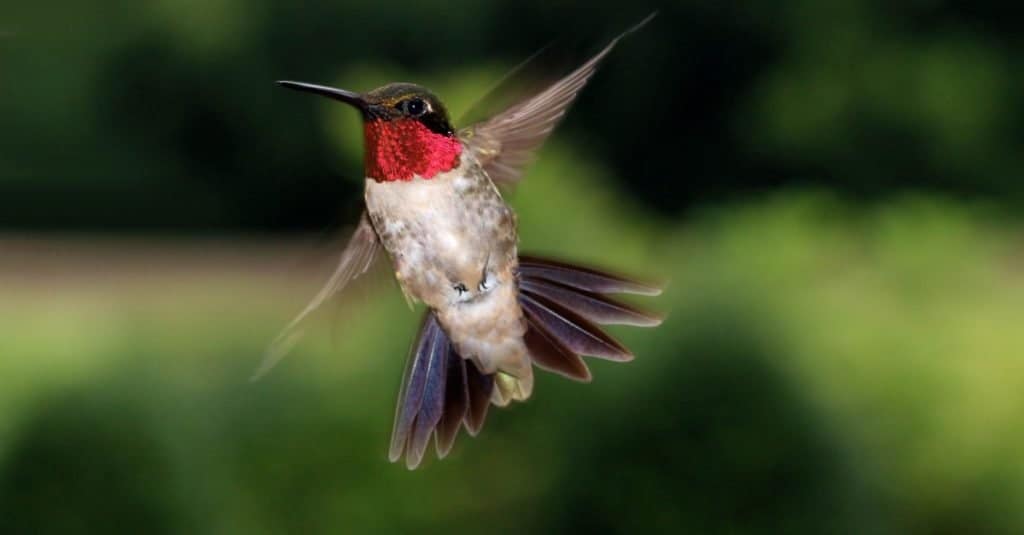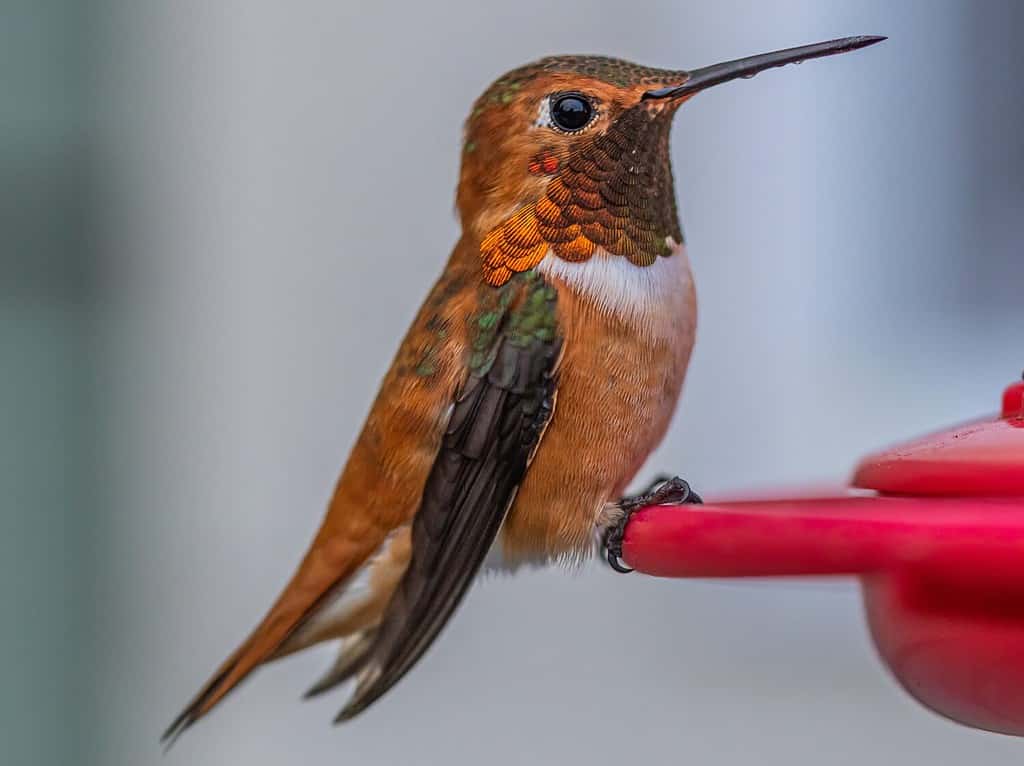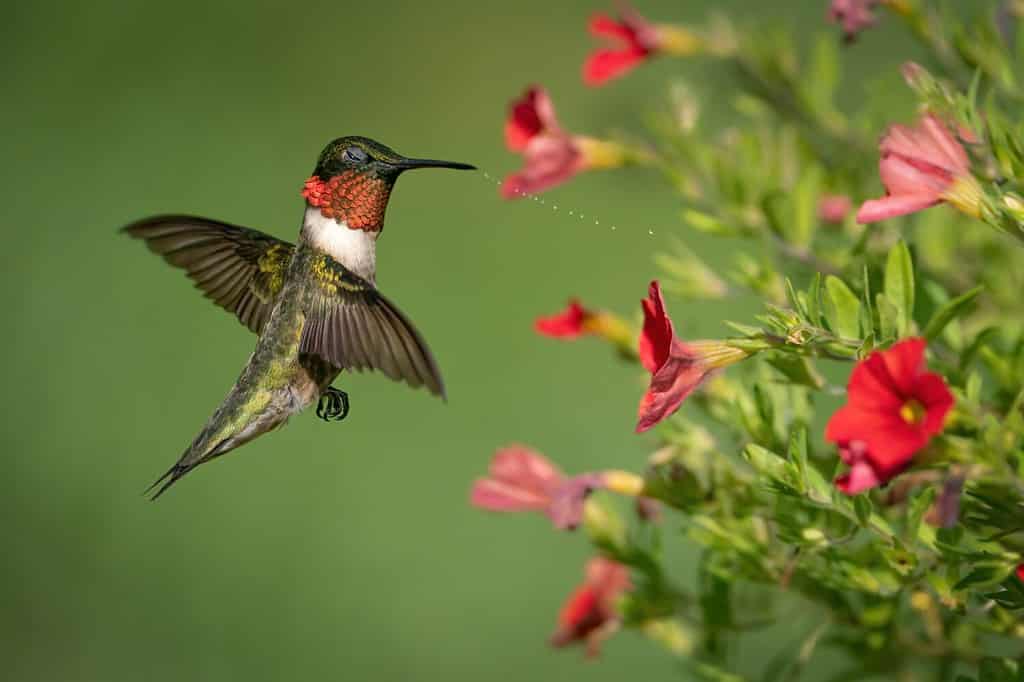Are you an avid bird enthusiast in North Carolina? Perhaps you have a specific fascination with hummingbirds. As the seasons change and the vibrant colors of summer give way to the warm hues of autumn, it’s natural to wonder when hummingbirds will bid farewell to the Tar Heel State. In this article, we will delve into the fascinating world of these tiny avian wonders, uncovering the patterns and cues that signal their departure. By understanding when hummingbirds leave North Carolina, you can make the most of your birdwatching experiences and ensure you don’t miss these fleeting visitors!
When Do Hummingbirds Leave North Carolina?

The
ruby-throated hummingbird
(Archilochus colubris) is a hummingbird species that is commonly seen in North Carolina.
©John L. Absher/Shutterstock.com
Hummingbirds leave North Carolina as the weather cools, and they begin their migratory journey to their winter homes. The exact timing of their departure can vary, but it typically occurs from late summer to early fall. September is a common month for their departure, with some hummingbirds starting their migration as early as August. By mid-October, most hummingbirds have left the state.
Key Points on the Departure Timeline:
It’s important to note that some hummingbirds may spend the winter in North Carolina. While most hummingbirds migrate to warmer regions, there are some species that over-winter in the Carolinas.
Hummingbird Departure in North Carolina: Signs to Look Out For
Decreased Hummingbird Activity:
As summer transitions to fall, one of the first signs of hummingbird departure is a decrease in their activity around feeders and flowers. The hummingbirds may visit less frequently or spend shorter periods at feeders as they start preparing for their long journey. Keep a watchful eye for this change in behavior.
Reduced Food Consumption:
Another indication of hummingbird departure is a decrease in their food consumption. As they begin their migratory journey, their energy needs decrease, resulting in lower nectar intake. You may notice that your hummingbird feeders require refilling less often, as the birds don’t rely as heavily on them.
Increased Aggression:
In the weeks leading up to their departure, hummingbirds can become more territorial and aggressive. This behavior is particularly noticeable around feeders, as they fiercely defend their food sources before leaving. Witnessing hummingbirds engage in aerial battles and vocal disputes is a clear sign that they are preparing to depart.
Molting Feathers:
Hummingbirds undergo a molting process during late summer and early fall, replacing old feathers with new ones for optimal flight during migration. Keep an eye out for tiny feathers scattered near feeders or on the ground, as this indicates that the hummingbirds are preparing themselves for their long journey.
Native Hummingbird Species Migration in North Carolina:
Now, let’s delve into the fascinating migration patterns of native hummingbird species in North Carolina, shedding light on their remarkable journeys and providing insights into how you can support and enjoy their presence.
Ruby-throated Hummingbird Migration:

Ruby-Throated Hummingbirds typically migrate from North Carolina in late summer, or early fall to spend winters in Central America.
©Ramona Edwards/Shutterstock.com
The Ruby-throated Hummingbird, the most common hummingbird species in North Carolina, embarks on a remarkable migration from the state. These tiny birds travel thousands of miles to Central America and Mexico, crossing the Gulf of Mexico in a non-stop flight that is awe-inspiring. Look for the following signs indicating their departure:
Non-Native Species Of Hummingbirds That Migrate Through North Carolina
Rufous Hummingbird Migration:

Ruby-throated hummingbirds typically migrate through North Carolina during their migration to Mexico.
©Panduh Productions/Shutterstock.com
Although less common, the Rufous Hummingbird also migrates through North Carolina during its journey. These feisty birds breed in the Pacific Northwest and Alaska, but they undertake an incredible migration to Mexico, passing through North Carolina along the way. Observing this species can be a rare treat for bird enthusiasts, so keep your eyes peeled for unusual sightings!
Are There Any Hummingbirds That Spend The Winter In North Carolina?
As mentioned earlier, some hummingbirds actually spend the winter in North Carolina. For example, although Ruby-throated Hummingbirds are known for their long migrations to Central America and Mexico, some individuals have been observed spending the winter along the coast of North Carolina. This phenomenon is more commonly seen in recent years due to milder winter temperatures.
Leaving your hummingbird feeders up throughout the autumn can attract not only these wintering hummingbirds but also other species that migrate from the north and west to feed.
Factors Influencing Hummingbird Migration Patterns in North Carolina
Hummingbirds are fascinating creatures known for their long migrations to and from North Carolina. Understanding the factors that influence their migration patterns can provide valuable insights into their behavior and help us appreciate these tiny marvels even more.
Here are some key factors that play a role in hummingbird migration patterns in North Carolina:
Seasonal Changes:
Hummingbirds are sensitive to changes in daylight hours and temperature. As the days become shorter and cooler, signaling the arrival of fall, hummingbirds instinctively prepare for migration. They rely on these environmental cues to guide their journey, ensuring they leave North Carolina in search of more favorable conditions.
Food Availability:
Hummingbirds have a high metabolism and need to consume nectar from flowers to fuel their long flights. The availability of nectar-rich flowers plays a crucial role in determining when and where hummingbirds migrate. In North Carolina, the blooming patterns of specific flowers, such as trumpet vines and red buckeyes, can influence hummingbird migration. These birds will follow the nectar trail, moving to regions where food sources are abundant.
Climate and Weather:
Weather conditions, including wind patterns, temperature fluctuations, and precipitation, can significantly impact hummingbird migration. Strong headwinds can make their flights more challenging, prompting them to stay in an area until conditions improve. Sudden drops in temperature can also trigger hummingbirds to migrate earlier than usual.
Geography and Habitat:
The geographical features and habitat types in North Carolina can shape hummingbird migration patterns. Mountain ranges, rivers, and coastal areas can act as natural barriers or corridors, influencing the routes that hummingbirds take. Additionally, the availability of suitable nesting sites and resting places along their migration route can affect their movements.
Genetic Predisposition:
Recent research suggests that genetics may also play a role in hummingbird migration behavior. Certain genetic traits can influence the timing and route of migration for individual birds. This genetic predisposition, combined with environmental factors, contributes to the unique migration patterns observed in North Carolina.
Hummingbird Migration and the Impact on North Carolina’s Ecosystem

Hummingbirds are crucial pollinators to the native flowers in North Carolina making them valuable to the ecosystem.
©Cavan-Images/Shutterstock.com
The annual migration of these tiny birds has a profound impact on the delicate balance of nature. Given the fact that hummingbirds are crucial pollinators, let’s explore how hummingbird migration influences North Carolina’s ecosystem:
Pollination Powerhouses:
As hummingbirds flit from flower to flower in search of nectar, they inadvertently become crucial pollinators. Their long beaks and specialized tongues allow them to reach deep into flowers, collecting and transferring pollen from one bloom to another. This important pollination process ensures the reproduction and diversity of plant species throughout North Carolina’s ecosystem.
Plant Diversity:
Hummingbirds have unique preferences when it comes to selecting flowers. They are attracted to brightly colored, tubular blossoms that contain ample amounts of nectar. By visiting a wide variety of flowers, hummingbirds help promote the diversity of plant species in North Carolina. Their selective feeding habits contribute to the proliferation of specific flora, which, in turn, supports a rich and vibrant ecosystem.
Seed Dispersion:
While feeding on nectar, hummingbirds inadvertently assist in seed dispersion. As they move from flower to flower, they may brush against the plant’s reproductive organs, picking up pollen or inadvertently collecting seeds on their feathers. When they visit other flowers, some of this pollen or seeds may be transferred, contributing to the dispersal and propagation of plant species across different regions of North Carolina.
Predator-Prey Relationships:
Hummingbirds form an essential part of the food web in North Carolina’s ecosystem. Their presence attracts predators such as spiders, praying mantises, and other insects, which rely on them for sustenance. By serving as a food source for these predators, hummingbirds help maintain a balanced predator-prey relationship that ensures the overall health and stability of the ecosystem.
Ecotourism and Conservation:
The mesmerizing migration of hummingbirds in North Carolina draws nature enthusiasts and birdwatchers from far and wide. This influx of visitors not only boosts local economies but also fosters a greater appreciation for the conservation of natural habitats. The preservation of hummingbird-friendly environments, including the protection of nectar-rich flowers and suitable nesting sites, becomes crucial to ensuring the continued presence of these remarkable birds.
Where Do Hummingbirds Go When They Leave North Carolina?
Although most hummingbirds typically travel south, there are different places and routes they take when it comes to settling for the winter. Let’s delve into the fascinating world of hummingbird migration and discover where these tiny aviators go when they bid farewell to North Carolina!
Central and South America:
The majority of hummingbirds that leave North Carolina embark on an epic journey to Central and South America. These regions provide a favorable climate and abundant food sources for their survival during the colder months. Countries such as Mexico, Costa Rica, Colombia, Ecuador, and Brazil become their wintering grounds, offering a haven of warmth and nectar-rich flowers.
Migration Routes:
Hummingbirds follow specific migration routes known as flyways. The two primary flyways for North American hummingbirds are the Eastern Flyway and the Central Flyway. Hummingbirds that leave North Carolina typically travel along the Eastern Flyway, which takes them southward along the Atlantic Coast, crossing the Gulf of Mexico, and eventually reaching their wintering grounds in Central and South America.
Stopover Sites:
During their long journey, hummingbirds make stopovers at various locations to rest and refuel. These stopover sites provide crucial resources such as nectar-producing plants and insects. Popular stopover sites for North Carolina’s hummingbirds include the Gulf Coast states, Florida, and the Caribbean islands. These temporary resting spots allow them to replenish their energy before continuing their arduous journey.
Wintering Grounds:
Once hummingbirds reach their wintering grounds in Central and South America, they find a haven where they can thrive. The tropical climates of these regions offer a year-round abundance of flowering plants and insects. Hummingbirds adapt to these different environments and become an integral part of the local ecosystems, pollinating flowers and contributing to the overall biodiversity of the region.
Return Migration:
As winter gives way to spring, hummingbirds begin their return migration back to North Carolina. They follow a similar route, flying northward along the Eastern Flyway, stopping at familiar locations to rest and refuel along the way. The availability of nectar-producing flowers and suitable nesting sites in North Carolina serves as a beacon, drawing them back to their breeding grounds.
When Do Hummingbirds Return To North Carolina?
Hummingbirds begin their annual spring migration from their wintering grounds in Central and South America to North Carolina in search of suitable breeding habitats. The timing of their return is influenced by factors such as weather patterns, availability of food, and the lengthening of daylight hours. Typically, hummingbirds start arriving in North Carolina in early to mid-April.
First Sightings:
Keen-eyed birdwatchers eagerly await the first sightings of hummingbirds in North Carolina. These sightings often occur in the southernmost regions of the state first, where the climate is slightly warmer. As the days progress and temperatures rise, hummingbirds gradually make their way to more northern parts of North Carolina.
How To Help Hummingbirds When They Return to North Carolina

Ruby Throated Hummingbirds love hummingbird feeders.
©Christine Balleau/iStock via Getty Images
Here are some actionable tips on how to assist hummingbirds when they return to North Carolina:
Plant Nectar-Rich Flowers:
Hummingbirds have a voracious appetite for nectar, so planting a variety of nectar-rich flowers is essential. Choose native flowering plants such as bee balm, cardinal flower, and trumpet vine, as they are well-suited to the local climate and attract hummingbirds with their vibrant blooms.
Hang Hummingbird Feeders:
Supplement the natural nectar sources by hanging hummingbird feeders in your garden. Fill them with a homemade or store-bought nectar solution of four parts water and one part white granulated sugar. Ensure the feeder is clean and kept filled with fresh nectar, especially during peak migration and breeding seasons.
Provide Shelter and Nesting Materials:
Hummingbirds seek shelter in trees, shrubs, and dense vegetation. Consider planting dense evergreen trees or shrubs that provide protection and perching spots for these tiny flyers. Additionally, leaving spider webs intact can serve as a valuable nesting material for hummingbirds.
Avoid Pesticides:
Hummingbirds feed on insects for protein, so it’s crucial to avoid using harmful pesticides in your garden. Opt for natural pest control methods or choose organic alternatives that don’t pose a threat to these delicate creatures.
Maintain Cleanliness:
Regularly clean and refill hummingbird feeders to prevent the growth of mold and bacteria. Clean the feeders with a solution of one part white vinegar and four parts water, rinsing thoroughly before refilling. This helps ensure the health and well-being of the hummingbirds visiting your garden.
Create Safe Flight Paths:
Hummingbirds are highly agile fliers, but they can occasionally collide with windows or other obstacles. To prevent accidents, place decals or window clings on glass surfaces to break up reflections. Additionally, positioning feeders and flowers away from windows can help redirect their flight paths.
Conserve Water:
Hummingbirds need water for drinking and bathing. Provide shallow water sources, such as birdbaths or shallow dishes, with rocks or twigs for perching. Change the water regularly to prevent stagnation and keep it clean for their use.
The photo featured at the top of this post is © Steve Byland/Shutterstock.com
Thank you for reading! Have some feedback for us? Contact the AZ Animals editorial team.







